News
26 Mar 2018
Listen Here – Where Am I?
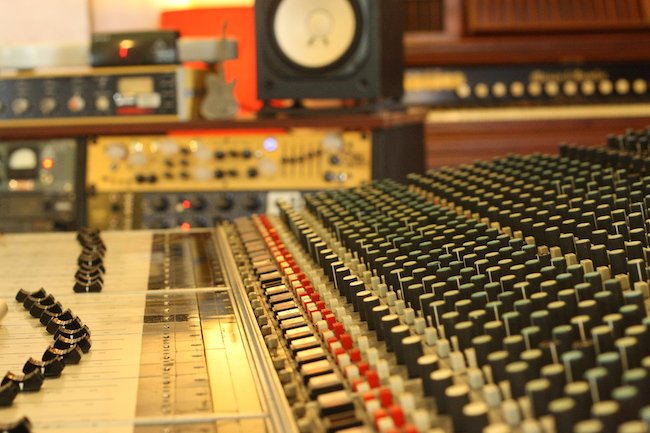
Subscribe to CX E-News
REGULARS
Listen Here – Where Am I?
By Andy Stewart.
When you mix a song, does it ever occur to you to ask yourself where things appear in the pseudo-physical space between your speakers? If you can answer this question for every sound in your mix you’re well on the way to creating a cool, three-dimensional soundstage.
Conversely, if you don’t ask this question repeatedly during a mix you may quickly find yourself swimming in reverb or wondering why things sounds flat and crowded.
Being able to ‘see’ where everything is in a mix through your mind’s eye is a crucial skill to develop as an engineer.
If you want that epic guitar to sound like it’s up the back of a giant warehouse, that trumpet to sound like it’s on the horizon in a desert landscape, or that main vocal to sound like it’s big and wet, and yet close at the same time, you need to be able to picture it first in your imagination, then work towards making that illusion a ‘reality’ with your eyes shut and your ears and mind open.
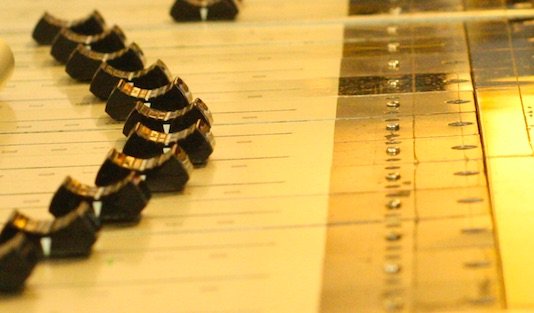
Questions you then need to quickly ask yourself, once you can ‘see’ what you’re after, relate directly to how that illusion of space can be created, like: “How far away is the sound from the listener?” and “Does it have a specific point of origin on the horizon or is it coming from everywhere?” Then there are others, like: “Is this sound proximate to walls, or is it outdoors where there aren’t any?” or “Is the sound close and big, or wide and asymmetrical?”
Or you can be far more off-the-wall, questioning things like whether a sound is morphing from a guitar into a shimmering lake, or if it’s moving and elusive so that you can never really pin it down.
One of my favourite questions to ask is: “How far away is it, and will this distance affect my sound’s tone and width?” Another is: “Does the sound travel towards me, away from me, across my perspective from side to side, or at an oblique angle from mid left to close right like a cross-court tennis shot?”
Then there’s the occasional question of whether the sound is merging into (or out of) another sound, and whether this transformation is simply about cross-fading the two or building an elaborately complex aural metamorphosis. At least one of those scenarios somewhere in a mix is a cool thing!
PUSH YOUR BOUNDARIES
There are endless questions like this you could ask yourself during a mixing session – the important thing is that you ask questions in the first place. Sometimes the simple act of querying a sound’s context is enough to clarify a problem you may be facing, enough to crack the mix wide open in your mind.
Importantly, you can’t settle for near enough is good enough halfway through the process. You’ve got to keep working on a sound until the image you first conjured up in your mind comes to life aurally.
Settling for something vaguely reminiscent of what you first imagined tends only to lead to mediocre, wishy-washy sounds that lack individuality and definition. You have to see the visual image through – quite literally! – until the effect you’ve created becomes sonically convincing.
But to be clear, I’m not advocating for every mix to be a landscape painting or a pretty picture. You can picture anything: whether it’s physical, outrageously supernatural, or downright dull.
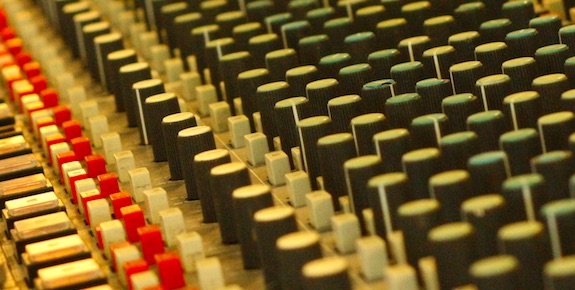
The important thing to understand is that by engaging yourself in a discourse about a sound’s place in the mix, you’re giving yourself direction and purpose, more like a builder with a draughtsman’s drawings than a magician with an upturned hat.
Steering the way you approach volume, tone, level, effects, panning and texture with clear questions can, with practise and determination, turn your flabby, indecipherable mixes into aurally engaging masterpieces.
ASKING PERSONAL QUESTIONS
When I mix I constantly maintain an internal conversation about where things are sitting in three-dimensional space.I like to think I’ve developed an extensive repertoire of skills over the years that I use to create these illusions that I see in my head.
But they’re hard won skills. They haven’t come easily nor are they acquired by osmosis… or maybe they are.
You see, creating illusions – which to some degree or other is simply a fancy term for ‘playing tricks on a listener to convince them of their aural surroundings’ – is all about triggering spatial memories that listeners already have in their head, whether they’re conscious of them or not.
Everyone – and I mean everyone, whether it be my four-year old son or an 80-year old grandmother – has an almost limitless menu of complex sounds that they’re constantly referencing against current surroundings.
For example, I’d almost guarantee that if you walked your husband or wife into your local shopping mall blindfolded, they’d almost immediately be able to tell you where they were, or at least the type of place they were in.
This incredible spatial referencing capability that our ears and brain somehow manage to pull off with ease every conscious waking moment of our lives is what we’re tapping into when we mix.
The problems of a poorly executed mix arise when we underestimate just how sophisticated our conscious mind is – even Joe Blow has incredible three-dimensional spatial awareness, though he knows nothing about music let alone mixing.
That’s why whacking a basic reverb on a sound without any thought or regard for tone, pre-delay or early reflections (or where they’re coming from) can often sound so underwhelming in a mix. You’ve got to work much harder than that to trick a listener’s mind in a convincing way.
That’s why it’s crucially important to imagine where a sound is in your mix first, and then work tenaciously towards it, remembering that every aspect of a sound has to work as one before an illusion is created.
And the key word here is ‘work’. Slap-dash plug-in presets plonked mindlessly on a sound are usually just that: slap-dash.
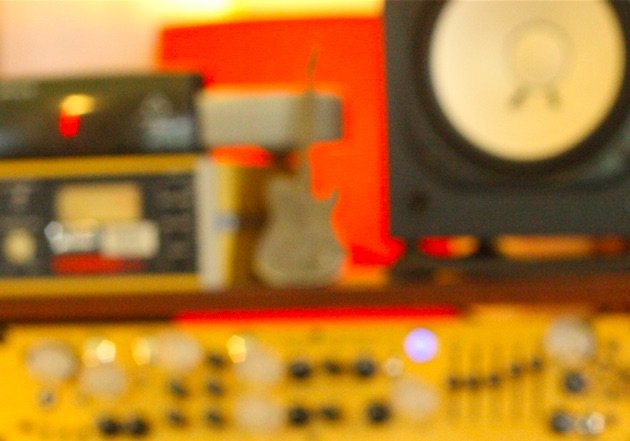
One slightly off-the-wall piece of advice I often give people that are looking to develop their illusion-oriented, sound-based skill set is to get them to become more consciously aware of their aural surroundings when they’re out of the studio and in the big wide world.
If you can get into the habit of analysing the sound of the world around you without driving your spouse nuts – it often makes you seem like you’re off with the fairies – it can work wonders for you back in the studio.
Wherever and whenever possible, analyse what it is about the environments you find in yourself in – whether you’re out hiking in a canyon, shopping in the supermarket or walking down a city street. Pay precise attention to they key sounds that convince you of your surroundings.
When you’re out hiking for example (well, someone must do it!) is the key that subtle delay off the hillside, perhaps? If so, what exactly is that sound like: how long is the delay component; what is its tonal signature; does it repeat or change? All this stuff becomes gold back in the studio when you put this information into practice.
Suddenly you hear that space again, and recall the experience of being out in the fresh air getting fit.
The great news is that our brains are also great at filling in the gaps, so you don’t have to know everything about a real-world sound reference, just some of its highlights. The listener does the rest; comparing your sound with one from their own extensive reference library, and bingo, the illusion is created!
Mixes are about a lot of things but without doubt one of the key ingredients is understanding of how three-dimensional space works – in practical terms. Once you can pull that off convincingly between two, you’re into a whole new realm of professionalism.
Andy Stewart owns and operates The Mill in the hills of Bass Coast in Victoria. He’s happy to respond to any pleas for recording or mixing help… Contact him at: andy@themillstudio.com.au
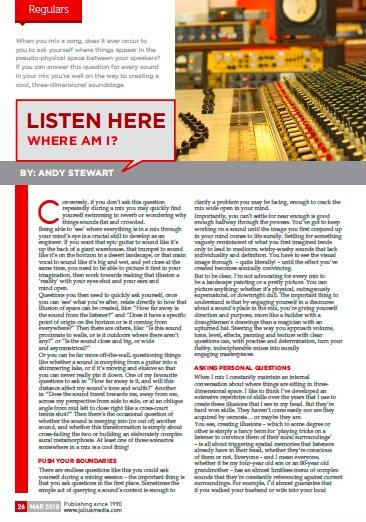
This article first appeared in the print edition of CX Magazine March 2018, pp.26-27. CX Magazine is Australia and New Zealand’s only publication dedicated to entertainment technology news and issues. Read all editions for free or search our archive www.cxnetwork.com.au
Subscribe
Published monthly since 1991, our famous AV industry magazine is free for download or pay for print. Subscribers also receive CX News, our free weekly email with the latest industry news and jobs.






